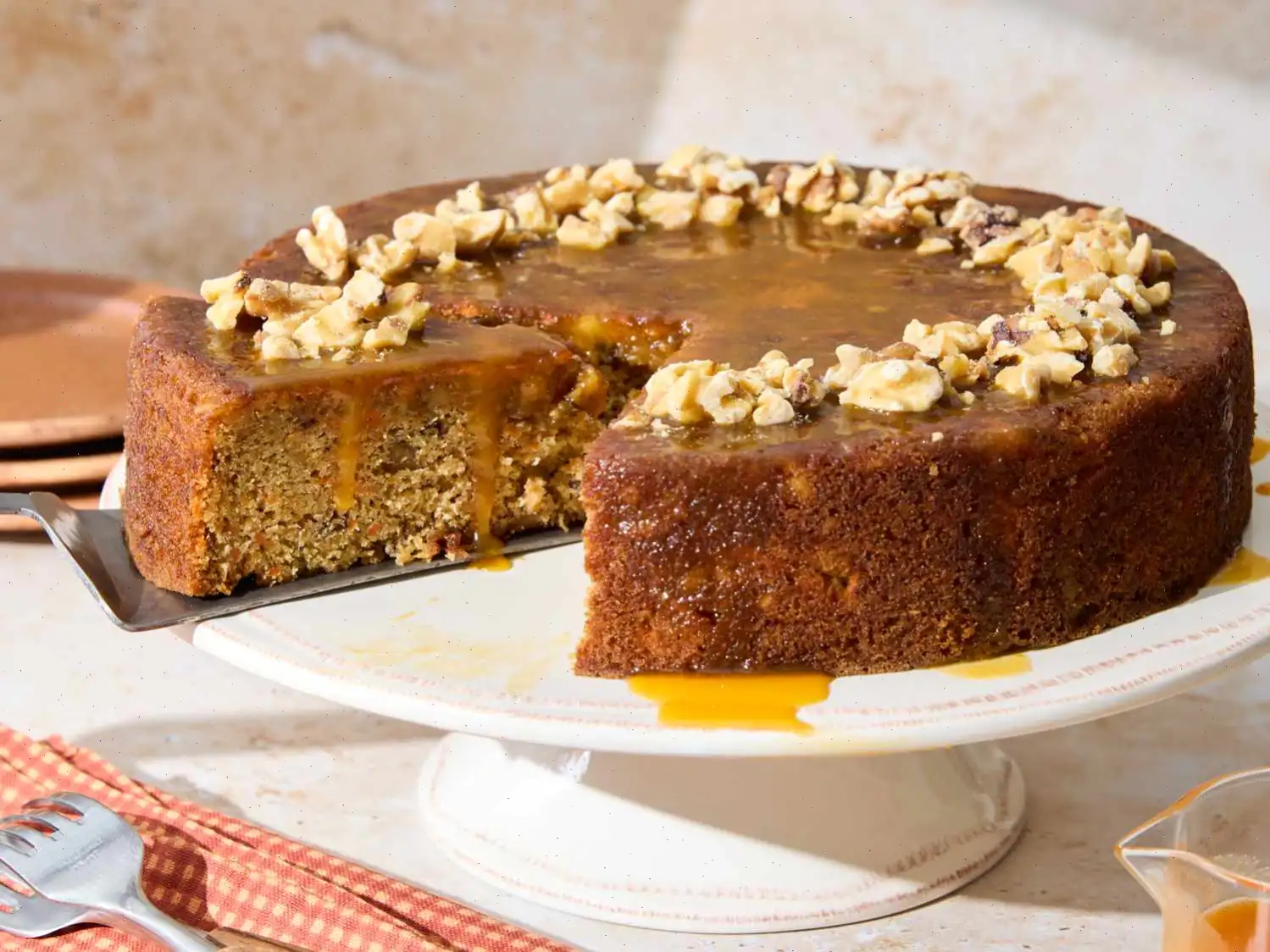
Capirotada (Mexican Bread Pudding) Recipe
This cinnamon bread pudding is a warm, comforting dessert that combines sweet, buttery bread with a rich cinnamon syrup. A perfect treat for any occasion, it is easy to prepare and sure to be a crowd-pleaser!
Ingredients
- 2 cups white sugar
- 2 cups water
- 10 cinnamon sticks
- 1 (1 pound) loaf white bread, cut into -inch thick slices
- 2 tablespoons butter
- 1 cup raisins
- 1 cup pineapple chunks, drained
- 4 ounces Colby longhorn cheese
- cup pine nuts or chopped walnuts
Directions
Step 1: Preheat the oven to 350F (175C).
Step 2: In a medium saucepan, combine the sugar, water, and cinnamon sticks. Bring the mixture to a boil, then reduce the heat and let it simmer for about 15 minutes. Once done, set aside.
Step 3: Toast the bread slices and butter one side of each slice.
Step 4: In a large casserole dish, arrange the buttered bread slices in a single layer.
Step 5: Sprinkle a portion of the raisins, pine nuts (or walnuts), and pineapple chunks on top of the bread.
Step 6: Slice the cheese and place a few slices on top of the fruit layer.
Step 7: Repeat the layering process until all the bread is used up, ensuring there is enough cheese left for the top layer.
Step 8: Pour the cinnamon syrup mixture over the layered bread and fruit.
Step 9: Place the casserole dish in the preheated oven and bake for 30 minutes.
Step 10: Allow the bread pudding to cool for at least 15 minutes before serving.
Nutrition Facts
| Per Serving | Amount | % Daily Value |
|---|---|---|
| Calories | 465 | |
| Total Fat | 13g | 17% |
| Saturated Fat | 5g | 23% |
| Cholesterol | 17mg | 6% |
| Sodium | 398mg | 17% |
| Total Carbohydrate | 83g | 30% |
| Dietary Fiber | 4g | 15% |
| Total Sugars | 55g | |
| Protein | 8g | 16% |
| Vitamin C | 3mg | 3% |
| Calcium | 200mg | 15% |
| Iron | 3mg | 15% |
| Potassium | 255mg | 5% |
Note: Nutritional values are based on a 2,000 calorie diet. Adjustments may be necessary based on your specific dietary needs.

History and Origins
Capirotada is a traditional Mexican dessert with deep historical roots, dating back to colonial times. It was originally created as a way to use up stale bread, and its evolution is a reflection of the cultural fusion that occurred in Mexico during the Spanish colonial period. The dish combines indigenous ingredients like corn and chocolate with European influences such as cinnamon, raisins, and bread, creating a uniquely Mexican dessert. Capirotada was traditionally prepared during Lent, when meat was avoided, and often served as a symbolic dish, with its various ingredients representing aspects of Christian faith, such as the bread representing the body of Christ, the syrup representing the passion, and the cheese symbolizing purity.
Regional Variations
While Capirotada is a beloved dessert throughout Mexico, its preparation varies across different regions. In northern Mexico, it may be made with cheese that is a bit more salty, while in southern regions, tropical fruits like pineapple and coconut are often added. The choice of nuts can also vary, with walnuts or pecans being the most common. The dessert is often flavored with the addition of cloves or even piloncillo (a type of raw sugar), which imparts a unique caramelized flavor. In coastal regions, coconut is sometimes included, giving the pudding an added richness. These regional variations reflect the diversity of Mexican cuisine and the availability of local ingredients.
How It Differs from Similar Dishes
Capirotada is often compared to other types of bread puddings, such as the American or British versions. However, there are several key differences. While traditional bread puddings are typically made with eggs, milk, and sugar, Capirotada uses a syrup made from sugar, water, cinnamon, and sometimes cloves, which gives it a distinctive flavor. The use of cheese is another unique feature that sets it apart, adding a savory element to the sweet dish. Additionally, the incorporation of fruits and nuts provides a rich texture that makes Capirotada distinct from its counterparts in other countries. This combination of sweet and savory ingredients, along with the texture contrasts, makes Capirotada an exceptional dessert.
Where Capirotada is Typically Served
Capirotada is most commonly enjoyed during religious holidays, particularly Lent and Easter, when it is served as a dessert or snack to break the fast. It is also a popular dish for family gatherings, celebrations, and potlucks across Mexico. In fact, many families have their own variation of the recipe, passed down through generations. While it is not typically found in high-end restaurants, it is a common homemade treat in Mexican households and can also be found at street food markets and some regional eateries. Its popularity during Lent also makes it a special dish in Catholic communities across Mexico.
Fun Facts About Capirotada
- One of the key ingredients, piloncillo, is a type of unrefined sugar commonly used in Mexican cooking. It adds a deep, molasses-like flavor to the syrup used in the pudding.
- Although the dish is most commonly served as a dessert, it was originally a way to avoid wasting old bread, which was a common practice in many cultures during times of scarcity.
- The use of cheese in Capirotada may seem unusual, but it provides a rich, creamy element that balances the sweetness of the syrup and fruits. In some regions, aged or hard cheeses are used to add more depth of flavor.
- Over time, Capirotada has evolved from a humble leftover dish to a beloved holiday treat that is now enjoyed by families all year round.
FAQ about Capirotada (Mexican Bread Pudding) Recipe
Comments
Jeffrey Williams
10/16/2022 04:34:56 PM
I made this dessert to go along with Rick's enchiladas. I didn't have pineapple, so I served it with mandarin oranges instead. I also added lemon juice and orange zest to the syrup. It was delicious! And just when you think it couldn't get any sweeter, I topped it off with whipped cream.
Julie Collins
06/23/2024 04:43:15 AM
I absolutely loved this recipe! Instead of just using raisins, I decided to mix in a "Fruit Medley" which included a variety of chopped dried fruits like apricots, apples, pears, sultanas, and a few raisins among others between the layers. It was a huge hit at the dinner party, with everyone raving about it. We served it with a generous dollop of cream, which complemented the flavors perfectly. For those who find walnuts too strong, you can easily swap them out for chopped pecans. Thanks for the amazing recipe, Lyn Smith!
Amy Scott
04/21/2024 02:58:06 AM
Quite good! Overall, my experience was positive.
Jonathan Adams
08/25/2023 04:07:20 AM
Very delicious, but it lacked moisture for my liking. I ended up adding a little more pineapple juice and cream to enhance the texture.
Debra Nelson
05/18/2025 12:16:17 AM
Alright but I was accustomed to the way my mother prepared it, which was similar except she used anise tea instead of water, giving it a really great taste.








